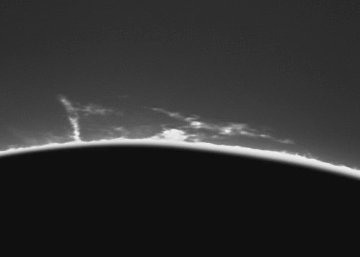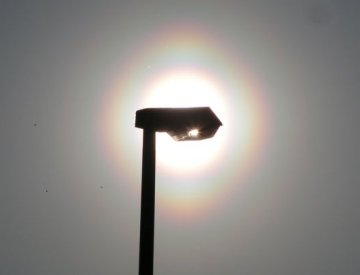| FLYBY ALERT! Space shuttle Discovery launches on May 31st. Get your flyby alerts from Space Weather PHONE | | | GLOBAL SAT-TRACKING: SpaceWeather.com's simple Satellite Tracker has gone global. It now works not only for US and Canadian readers, but also for sky watchers in countries around the world. Please try it and let us know how you like it. SOLAR VORTEX: "In spite of solar minimum, there seems to be plenty of action on the sun," reports amateur astronomer Peter Schlatter of Wohlen, Switzerland, who yesterday witnessed a spectacular vortex swirling on the sun's eastern horizon. Click on the image to launch the movie he made using his backyard telescope and a Coronado solar filter: 
movie formats: Quicktime, mp4, avi
Indeed, the limb of the sun is where the action is. "A huge prominence emerged today looking like a monster rising from a sea of fire," reports David Leong of Hong Kong: photo. None of this activity is explosive or threatens to cause geomagnetic storms on Earth--it's just a pretty show. If you have a solar telescope, take a look. more images: from Pascal Paquereau of Mouzeuil-Saint-Martin, Vendée, France; from Mark Seibold of Oregon; from Tom King of Watauga, Texas; from Maxim Usatov of Prague, Czech Republic; POLLEN CORONAS: It begins with a sneeze. Pollen floating through the air tickles your nose, and your body responds by expelling the allergen. Gesundheit! That's German for "look at the sun." Not really, but look anyway. The same pollen that makes you sneeze can also make beautiful coronas around the sun, like this one photographed on May 11th by Reinhard Nitze of Barsinghausen, Germany: 
"Coronas are produced when light waves scatter from the outsides of small particles," says atmospheric optics expert Les Cowley. "Tiny droplets of water in clouds make most coronas, but opaque equal-sized pollen grains do even better. They make small but very colorful multi-ringed coronas." "Unlike water droplets, pollens are non-spherical--and this adds to their magic," he continues. "Many have air sacs to help carry them in the wind. These align the grains to give beautiful elliptical coronas with bright spots." This is why Nitze's pollen corona looks the way it does. "So, the next time you sneeze..." Gesundheit! "...look for coronas near the sun." more images: from Eva Seidenfaden of Trier, Germany
April 2008 Aurora Gallery
[Aurora Alerts] [Night-sky Cameras] | 
